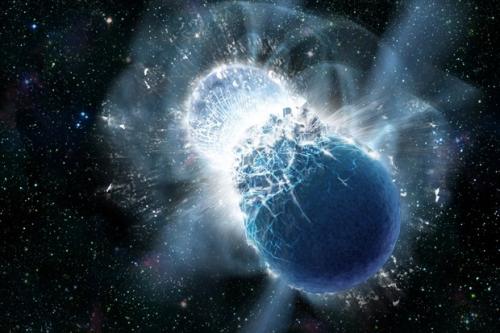(单词翻译:单击)
High-energy cosmic rays are flying through space and bombarding the Earth every day.
高能宇宙射线在宇宙间穿梭,每天都在撞击着地球。
We just can't see them.
只是我们肉眼看不见。
They're also to blame for a strange side-effect of space travel: mysterious flashes of light that astronauts see out of the corners of their eyes.
高能宇宙射线还导致了一种宇宙飞行中的奇怪副作用:宇航员总会在眼角外看到神秘的闪光。
These so-called cosmic ray visual phenomena have been reported enough times that scientists are trying to research what's going on with astronaut eyeballs.
关于这些所谓的宇宙射线可视现象已经有了很多的报道,所以科学家正在努力研究宇航员的眼球经历了些什么。
But we still don't really understand why these flashes happen, or how exactly cosmic rays damage eyes and nervous systems, so we can better protect our astronauts.
但我们仍然不明白这样的闪光现象为何会发生,我们也不知道宇宙射线对眼睛和神经系统会造成怎样的伤害,所以我们也就无法对症下药地保护宇航员。
Despite the name, cosmic rays aren't really rays of light at all.
虽然宇宙射线名字里带个“射线”,但他们其实并不是射线。
They're extremely high-energy subatomic particles, mostly protons or atomic nuclei, that are being flung through space and bombarding the Earth.
它们其实是高能量的亚原子粒子,大部分都是质子或原子核,它们迸发而出后会不断地撞击地球。
We're not exactly sure where cosmic rays come from.
我们还不太确定宇宙射线从何而来。
One main theory is that explosive supernovae outside of our solar system basically act like huge, natural particle accelerators and generate them.
有一个主要的理论认为,位于太阳系外的爆炸性超新星就像大型的天然微粒加速器一样,正是这种加速器产生了宇宙射线。
Now, Earth's magnetic field is pretty good at protecting us surface-dwellers from cosmic rays and other charged particles, like the ones from solar wind, by deflecting them.
地球的磁场可以很好地保护人类不受宇宙射线和其他带电粒子的伤害。其他带电粒子比如太阳风中的带电粒子。保护的方法就是让这些粒子发生偏转。
Lots of these energetic particles are trapped in donut-shaped bands around the Earth called the Van Allen belts, which are like radiation-filled minefields for anything floating around in space.
很多高能粒子被困在了地球周围形似甜面圈的地带里,这里就是范艾伦辐射带。这个地带有点像充满了辐射的雷区,可以辐射到宇宙里飘荡的任何物体。
We try to make sure our Earth-orbiting satellites and space stations are nestled in the gaps between Van Allen belts, to keep the people and equipment safe.
我们试图确定围绕地球的卫星和空间站在范艾伦辐射带之间的地带安然无恙,这样就可以保证人和设备的安全了。
But there are certain regions, like one called the South Atlantic Anomaly, that orbiting spacecrafts end up passing through.
但是有些区域是宇宙飞船的必经之处,比如南大西洋异常区。
So unfortunately they get bombarded with all those high-energy particles.
所以,很不幸,这样的地区是会受到高能粒子的撞击的。
All that radiation isn't great for humans, and is one of the biggest dangers of spending a lot of time in space, outside of the protective blanket of Earth's magnetic field.
这样的辐射对人类来说并不是好事,而且因在宇宙里待的时间过长而面临的诸多重大危险中就有高能辐射这一项。这里说的“宇宙里”是指地球磁场保护性地带以外的地方。
That's why organizations like NASA study astronaut health so carefully.
正因如此,包括美国宇航局在内的一些组织会如此审慎地研究宇航员的健康问题。
Long-term exposure might increase astronauts' risk of getting cancer, and it has weird, harmful effects on their eyes and nervous systems, like increasing the likelihood of cataracts many years later.
长期暴置于高能射线的环境中可能会增加宇航员患癌症的风险,对宇航员的眼睛和神经系统也会产生奇怪、有害的影响,比如多年后会增加宇航员患白内障的可能性。
Sometimes, when astronauts are exposed to cosmic rays, they even start seeing flashes of light every few minutes, which we call cosmic ray visual phenomena.
有时候,暴置于宇宙射线中的宇航员甚至开始每隔几分钟看到闪光。我们将这种现象称为宇宙射线可视现象。
Some space travelers are especially sensitive to the flashes, while others never report noticing them at all.
一些宇航员对这种闪光现象尤其敏感,还有一些宇航员甚至都没注意到闪光的存在。
The Apollo astronauts who first described them said that they mostly look like spots, though sometimes they appear to be streaks and clouds.
阿波罗号首次发现闪光现象的宇航员表示,这些闪光点看起来像圆点一样,虽然有时候也可能会呈现出条纹和云朵的形状。
They were bright enough that they even kept some astronauts awake at night.
这种闪光的亮度太高,导致一些宇航员夜不能寐。
By taking a close look at the Apollo astronauts' helmets, NASA was able to see tracks left by subatomic particles passing through the plastic.
通过仔细研究阿波罗号宇航员的头盔,美国宇航局可以发现亚原子粒子在穿过头盔的塑料时留下的蛛丝马迹。
And in the 1970s, some ground-based scientists conducted some maybe-not-super-safe experiments.
上世纪70年代,一些陆基科学家进行了一些没有完全把握的试验。
They had people look at neutron beams in dark rooms, which caused similar flashes to appear in their vision.
他们让参与试验的人凝视黑暗房间里的中子束,随后,这些人看到有类似的闪光现象出现。
Some more modern astronauts are outfitted with special helmets with cosmic ray detectors.
后来,科学家给宇航员配备了特殊的头盔,可以监测到宇宙射线。
The astronauts keep track of when they see a flash, to collect data on what types and energy levels of particles seem most likely to cause them,
宇航员会记录下看到闪光的时间点,通过收集的数据得出哪些种类和能级的粒子最有可能引发闪光现象,
and how often they appear in different parts of space.
以及闪光现象出现在宇宙不同地方的频率是怎样的。
So we're pretty sure that cosmic rays are the cause of the lights, and researchers hope to use these data to come up with better ways to protect astronauts from cosmic radiation.
所以我们相当确定的是:宇宙射线是引发闪光的原因。研究人员希望通过这些数据来找到更好的办法,保护宇航员不受宇宙射线的伤害。
But there's still a big mystery: we don't really know what's happening inside astronauts' eyeballs when these flashes occur.
但还有一个疑团:我们并不知道宇航员在看到闪光的时候眼球内部会发生什么。
One possible culprit is Cherenkov radiation, which causes the blue glow you might have seen in photos of nuclear reactors.
其中一个可能的罪魁祸首就是切伦科夫辐射,这种辐射引发了在核反应堆照片中可能会看到的蓝辉光。
Cherenkov radiation happens when really energetic particles pass through a liquid, faster than light can travel through it.
切伦科夫辐射发生的条件是:极具能量的粒子穿过了一种液体,其穿梭的速度要比光穿梭的速度更快。
Those particles can interact with some of the liquid molecules, which respond by emitting some photons of light -- the glowing Cherenkov radiation.
这些粒子会与一些液体分子发生作用,液体分子会放射出光量子,也就是发着光的切伦科夫辐射。
Cosmic rays passing through eyeball fluid could be generating some Cherenkov radiation, which astronauts see as spots and flashes.
穿梭过眼球液体的宇宙射线可能会产生一些切伦科夫辐射,这种辐射到了宇航员的眼中就变成了圆点和闪光。
Another possibility is that radiation from cosmic rays could interact weirdly with the retina, the tissue at the back of your eye that normally detects visual light.
还有一种可能性:宇宙射线的辐射会以奇怪的方式跟视网膜发生作用。视网膜就是眼睛后方的一个组织,这个组织正常情况下可以检测到可见光的存在。
Or, cosmic rays could bypass normal vision completely and pass right through the eyeball, directly stimulating the optic nerve or even the brain's visual cortex.
或者说,宇宙射线会穿梭过正常视觉,透过整个眼球,直接刺激视神经甚至是大脑的视皮质。
Scientists still aren't totally sure what the right explanation is, since it's hard to do research on the eyeballs of busy astronauts in space.
科学家还不确定正确的解释是哪种,因为很难对在宇宙中繁忙工作的宇航员做眼球的分析研究。
The flashes could even have multiple causes, which would explain why they don't all look the same.
闪光甚至有可能是多种原因导致的,这样就能解释它们为什么看起来惊人的一致了。
Cosmic ray visual phenomena are ultimately a pretty minor issue compared to being smashed by meteors or fried by solar flares.
与我们受到流星撞击或者受到太阳耀斑的烘烤相比,宇宙射线的可视现象只是小菜一碟。
But they are a possible indication of damage to astronauts' eyes or even brains.
但宇宙射线可能会对宇航员的眼睛甚至大脑造成损伤。
And cosmic radiation is one huge obstacle we have to contend with if we ever do leave our home planet behind to travel the galaxy.
但如果我们要离开地球去宇宙遨游的话,那么宇宙射线是我们必须攻克的巨大障碍。
Thanks for watching this episode of SciShow Space, and special thanks to our patrons on Patreon!
感谢收看本期的《太空科学秀》,尤其要感谢我们的观众朋友们!
If you'd like to help us keep making episodes like this one, go to patreon.com/scishow.
如果您想和我们一起学习类似于本期的太空知识的话,就请登录patreon.com/scishow吧!
And for more videos about the universe, go to youtube.com/scishowspace and subscribe!
如您想要观看有关宇宙的更多视频集锦,请登录并订阅youtube.com/scishowspace吧!


